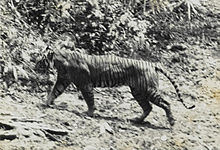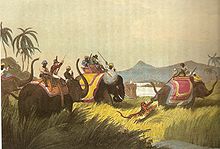| Revision as of 22:55, 24 February 2012 view source64.121.42.110 (talk)No edit summary← Previous edit | Revision as of 22:56, 24 February 2012 view source SkyMachine (talk | contribs)Rollbackers3,770 editsm Reverted 1 edit by 64.121.42.110 (talk) identified as vandalism to last revision by Rails. (TW)Next edit → | ||
| Line 39: | Line 39: | ||
| †'']'' | †'']'' | ||
| }} | }} | ||
| The ''' |
The '''tiger''' (''Panthera tigris'') is the largest ], reaching a total body length of up to {{convert|3.3|m|ft}} and weighing up to {{convert|306|kg|lb|abbr=on}}. Their most recognizable feature is a pattern of dark vertical stripes on reddish-orange fur with lighter underparts. They have exceptionally stout teeth, and their ] are the longest among living felids with a ] height of as much as {{convert|74.5|mm|in|abbr=on}} or even {{convert|90|mm|in|abbr=on}}.<ref name=Mazak1981>Mazák, V. (1981) Mammalian Species 152: 1–8.</ref> | ||
| In zoos, tigers have lived for 20 to 26 years, which also seems to be their longevity in the wild.<ref name="der-tiger">{{de icon}} Mazák, V. (1965) ''Der Tiger Panthera tigris Linnaeus 1758''. Volume 356 of Die Neue Brehm-Bücherei. A. Ziemsen, Wittenberg Lutterstadt.</ref> They are territorial and generally ] animals, often requiring large contiguous areas of habitat that support their prey requirements. This, coupled with the fact that they are indigenous to some of the more densely populated places on earth, has caused significant conflicts with humans. | In zoos, tigers have lived for 20 to 26 years, which also seems to be their longevity in the wild.<ref name="der-tiger">{{de icon}} Mazák, V. (1965) ''Der Tiger Panthera tigris Linnaeus 1758''. Volume 356 of Die Neue Brehm-Bücherei. A. Ziemsen, Wittenberg Lutterstadt.</ref> They are territorial and generally ] animals, often requiring large contiguous areas of habitat that support their prey requirements. This, coupled with the fact that they are indigenous to some of the more densely populated places on earth, has caused significant conflicts with humans. | ||
Revision as of 22:56, 24 February 2012
This article is about the feline. For other uses, see Tiger (disambiguation). "Tigress" redirects here. For other uses, see Tigress (disambiguation).
| Tiger Temporal range: Early Pleistocene – Recent | |
|---|---|

| |
| A Bengal tiger (P. tigris tigris) in India's Ranthambhore National Park. | |
| Conservation status | |
 Endangered (IUCN 3.1) | |
| Scientific classification | |
| Kingdom: | Animalia |
| Phylum: | Chordata |
| Class: | Mammalia |
| Order: | Carnivora |
| Family: | Felidae |
| Genus: | Panthera |
| Species: | P. tigris |
| Binomial name | |
| Panthera tigris (Linnaeus, 1758) | |
| Subspecies | |
|
P. t. tigris | |

| |
| Tiger's historic range in ca. 1850 (pale yellow) and range in 2006 (in green). | |
| Synonyms | |
|
Tigris striatus Severtzov, 1858 | |
The tiger (Panthera tigris) is the largest cat species, reaching a total body length of up to 3.3 metres (11 ft) and weighing up to 306 kg (675 lb). Their most recognizable feature is a pattern of dark vertical stripes on reddish-orange fur with lighter underparts. They have exceptionally stout teeth, and their canines are the longest among living felids with a crown height of as much as 74.5 mm (2.93 in) or even 90 mm (3.5 in). In zoos, tigers have lived for 20 to 26 years, which also seems to be their longevity in the wild. They are territorial and generally solitary but social animals, often requiring large contiguous areas of habitat that support their prey requirements. This, coupled with the fact that they are indigenous to some of the more densely populated places on earth, has caused significant conflicts with humans.
Tigers once ranged widely across Asia, from Turkey in the west to the eastern coast of Russia. Over the past 100 years, they have lost 93% of their historic range, and have been extirpated from southwest and central Asia, from the islands of Java and Bali, and from large areas of Southeast and Eastern Asia. Today, they range from the Siberian taiga to open grasslands and tropical mangrove swamps. The remaining six tiger subspecies have been classified as endangered by IUCN. The global population in the wild is estimated to number between 3,062 to 3,948 individuals, with most remaining populations occurring in small pockets that are isolated from each other. Major reasons for population decline include habitat destruction, habitat fragmentation and poaching. The extent of area occupied by tigers is estimated at less than 1,184,911 km (457,497 sq mi), a 41% decline from the area estimated in the mid-1990s.
Tigers are among the most recognisable and popular of the world's charismatic megafauna. They have featured prominently in ancient mythology and folklore, and continue to be depicted in modern films and literature. Tigers appear on many flags, coats of arms, and as mascots for sporting teams. The Bengal tiger is the national animal of Bangladesh and India.
Taxonomy and etymology
In 1758, Linnaeus first described the species in his work Systema Naturae under the scientific name Felis tigris. In 1929, the British taxonomist Reginald Innes Pocock subordinated the species under the genus Panthera using the scientific name Panthera tigris.
The word Panthera is probably of Oriental origin and retraceable to the Ancient Greek word panther, the Latin word panthera, the Old French word pantere, most likely meaning "the yellowish animal", or from pandarah meaning whitish-yellow. The derivation from Greek pan- ("all") and ther ("beast") may be folk etymology that led to many curious fables.
The word "tiger" is retraceable to the Latin word tigris meaning a spotted tigerhound of Actaeon. The Greek word tigris is possibly derived from a Persian source.

Characteristics and evolution
The oldest remains of a tiger-like cat, called Panthera palaeosinensis, have been found in China and Java. This species lived about 2 million years ago, at the beginning of the Pleistocene, and was smaller than a modern tiger. The earliest fossils of true tigers are known from Java, and are between 1.6 and 1.8 million years old. Distinct fossils from the early and middle Pleistocene were also discovered in deposits from China, and Sumatra. A subspecies called the Trinil tiger (Panthera tigris trinilensis) lived about 1.2 million years ago and is known from fossils found at Trinil in Java.
Tigers first reached India and northern Asia in the late Pleistocene, reaching eastern Beringia (but not the American Continent), Japan, and Sakhalin. Fossils found in Japan indicate that the local tigers were, like the surviving island subspecies, smaller than the mainland forms. This may be due to the phenomenon in which body size is related to environmental space (see insular dwarfism), or perhaps the availability of prey. Until the Holocene, tigers also lived in Borneo, as well as on the island of Palawan in the Philippines.
Characteristics

Tigers are muscular, have powerful forequarters, and especially in males, a large head. The ground coloration of their fur varies between tawny and xanthine orange or cinnamon brown in the southernmost populations, to between ochraceous-orange or zinc orange or capucine orange in the northernmost populations. The face is framed by long hairs that form whiskers, which are more conspicuous in males. The ventral parts are usually white. The body is marked with black or chaetura black stripes of various length, breadth and form. The pupils are circular with yellow irises. The rather small ears are rounded and black on their dorsal side with a conspicuous white central spot. These spots, called ocelli, play an important role in intraspecific communication.
The pattern of stripes is unique to each animal, these unique markings can be used by researchers to identify individuals (both in the wild and captivity), much in the same way that fingerprints are used to identify humans. It seems likely that the function of stripes is camouflage, serving to help tigers conceal themselves amongst the dappled shadows and long grass of their environment as they stalk their prey. The stripe pattern is also found on the skin of the tiger. If a tiger were to be shaved, its distinctive camouflage pattern would be preserved.

The tiger are the most variable in size of all big cats, even more so than the leopard and much more so than lions. The Bengal, Caspian and Siberian tiger subspecies represent the largest living felids, and rank among the biggest felids that ever existed. Females vary in size from 240 to 275 cm (94 to 108 in), weigh 85 to 167 kg (187 to 368 lb) with a greatest length of skull ranging from 268 to 318 mm (10.6 to 12.5 in). Males vary in size from 270 to 330 cm (110 to 130 in), weigh 170 to 306 kg (375 to 675 lb) with a greatest length of skull ranging from 316 to 383 mm (12.4 to 15.1 in). Body size of different populations seems to be correlated with climate—Bergmann's Rule—and can be explained from the point of view of thermoregulation. Large male Siberian tigers can reach a total length of more than 3.5 m (11 ft) "over curves", 3.3 m (11 ft) "between pegs" and a weight of 306 kg (675 lb). This is considerably larger than the size reached by the smallest living tiger subspecies, the Sumatran tiger, which reach a body weight of 75 to 140 kg (165 to 309 lb). At the shoulder, tigers may variously stand 0.7 to 1.22 m (2.3 to 4.0 ft) tall.
Tigresses are smaller than the males in each subspecies, although the size difference between male and female tigers tends to be more pronounced in the larger tiger subspecies, with males weighing up to 1.7 times more than the females. In addition, male tigers have wider forepaw pads than females. Biologists use this difference to determine gender based on tiger tracks. The skull of the tiger is very similar to that of the lion, though the frontal region is usually not as depressed or flattened, with a slightly longer postorbital region. The skull of a lion has broader nasal openings. However, due to the amount of skull variation in the two species, usually, only the structure of the lower jaw can be used as a reliable indicator of species.
Subspecies
There are nine subspecies of tiger, three of which are extinct. Their historical range in Bangladesh, Siberia, Iran, Afghanistan, India, China, and southeast Asia, including three Indonesian islands is severely diminished today. The surviving subspecies, in descending order of wild population, are:
- The Bengal tiger (Panthera tigris tigris) lives in India, Nepal, Bhutan and Bangladesh, and is the most common subspecies with populations estimated at less than 2,500 adult individuals. In 2011 the total population of adult tigers is estimated at 1,520–1,909 in India, 440 in Bangladesh, 155 in Nepal and 75 in Bhutan. It lives in alluvial grasslands, subtropical and tropical rainforests, scrub forests, wet and dry deciduous forests, and mangroves. Male Bengal tigers had a total length, including the tail, of 270 to 310 cm (110 to 120 in), while females range from 240 to 265 cm (94 to 104 in). The weight of males range from 175 to 260 kg (386 to 573 lb), while that of the females range from 100 to 181 kg (220 to 399 lb). In northern India and Nepal, tigers tend to be of larger size. Males often average 235 kilograms (518 lb), while females average 141 kilograms (311 lb). In 1972, Project Tiger was founded in India aiming at ensuring a viable population of tigers in the country and preserving areas of biological importance as a natural heritage for the people. But the illicit demand for bones and body parts from wild tigers for use in Traditional Chinese medicine is the reason for the unrelenting poaching pressure on tigers on the Indian subcontinent. Between 1994 and 2009, the Wildlife Protection Society of India has documented 893 cases of tigers killed in India, which is just a fraction of the actual poaching and illegal trade in tiger parts during those years. An area of special conservation interest lies in the Terai Arc Landscape in the Himalayan foothills of northern India and southern Nepal, where 11 protected areas comprising dry forest foothills and tall grass savannas harbor tigers in a 49,000 square kilometres (19,000 sq mi) landscape. The goals are to manage tigers as a single metapopulation, the dispersal of which between core refuges can help maintain genetic, demographic, and ecological integrity, and to ensure that species and habitat conservation becomes mainstreamed into the rural development agenda. In Nepal, a community-based tourism model has been developed with a strong emphasis on sharing benefits with local people and on the regeneration of degraded forests. The approach has been successful in reducing poaching, restoring habitats, and creating a local constituency for conservation.

- The Indochinese Tiger (Panthera tigris corbetti), also called Corbett's tiger, is found in Cambodia, China, Laos, Burma, Thailand, and Vietnam. These tigers are smaller and darker than Bengal tigers: Males weigh from 150–190 kg (330–420 lb) while females are smaller at 110–140 kg (240–310 lb). Their preferred habitat is forests in mountainous or hilly regions. According to government estimates of national tiger populations, the subspecies numbers around a total of 350 individuals. All existing populations are at extreme risk from poaching, prey depletion as a result of poaching of primary prey species such as deer and wild pigs, habitat fragmentation and inbreeding. In Vietnam, almost three-quarters of the tigers killed provide stock for Chinese pharmacies.

- The Malayan Tiger (Panthera tigris jacksoni), exclusively found in the southern part of the Malay Peninsula, was not considered a subspecies in its own right until 2004. The new classification came about after a study by Luo et al. from the Laboratory of Genomic Diversity Study, part of the National Cancer Institute of the United States. According to official government figures, the population in the wild may number around 500 individuals, but is under considerable poaching pressure. The Malayan tiger is the smallest of the mainland tiger subspecies, and the second smallest living subspecies, with males averaging about 120 kg and females about 100 kg in weight. The Malayan tiger is a national icon in Malaysia, appearing on its coat of arms and in logos of Malaysian institutions, such as Maybank.


- The Sumatran Tiger (Panthera tigris sumatrae) is found only on the Indonesian island of Sumatra, and is critically endangered. It is the smallest of all living tiger subspecies, with adult males weighing between 100–140 kg (220–310 lb) and females 75–110 kg (165–243 lb). Their small size is an adaptation to the thick, dense forests of the island of Sumatra where they reside, as well as the smaller-sized prey. The wild population is estimated at between 400 and 500, seen chiefly in the island's national parks. Recent genetic testing has revealed the presence of unique genetic markers, indicating that it may develop into a separate species, if it does not go extinct. This has led to suggestions that Sumatran tigers should have greater priority for conservation than any other subspecies. While habitat destruction is the main threat to existing tiger population (logging continues even in the supposedly protected national parks), 66 tigers were recorded as being shot and killed between 1998 and 2000, or nearly 20% of the total population.
- The Siberian tiger (Panthera tigris altaica), also known as the Amur tiger, inhabits the Amur-Ussuri region of Primorsky Krai and Khabarovsk Krai in far eastern Siberia. It ranks among the biggest felids that have ever existed with a head and body length of 160–180 cm (63–71 in) for females and 190–230 cm (75–91 in) for males, plus a tail of about 60–110 cm (24–43 in) and an average weight of around 227 kg (500 lb) for males. Siberian tigers have thick coats and a paler golden hue and fewer stripes. The heaviest wild Siberian tiger weighed 384 kg (847 lb) but according to Mazák this record is not reliable. In 2005, there were 331–393 adult-subadult Siberian tigers in the region, with a breeding adult population of about 250 individuals. The population has been stable for more than a decade, but partial surveys conducted after 2005 indicate that the Russian tiger population is declining. At the turn of the century, the phylogenetic relationships of tiger subspecies was re-assessed, and a remarkable similarity between the Siberian and Caspian tiger observed indicating that the Siberian tiger population is the genetically closest living relative of the extinct Caspian tiger, and strongly implying a very recent common ancestry for the two groups.

- The South China tiger (Panthera tigris amoyensis), also known as the Amoy or Xiamen tiger, is the most critically endangered subspecies of tiger and is listed as one of the 10 most endangered animals in the world. One of the smaller tiger subspecies, the length of the South China tiger ranges from 2.2–2.6 m (87–102 in) for both males and females. Males weigh between 127 and 177 kg (280 and 390 lb) while females weigh between 100 and 118 kg (220 and 260 lb). From 1983 to 2007, no South China tigers were sighted. In 2007 a farmer spotted a tiger and handed in photographs to the authorities as proof. The photographs in question, however, were later exposed as fake, copied from a Chinese calendar and digitally altered, and the “sighting” turned into a massive scandal.
In 1977, the Chinese government passed a law banning the killing of wild tigers, but this may have been too late to save the subspecies, since it is possibly already extinct in the wild. There are currently 59 known captive South China tigers, all within China, but these are known to be descended from only six animals. Thus, the genetic diversity required to maintain the subspecies may no longer exist. Currently, there are breeding efforts to reintroduce these tigers to the wild.
Extinct subspecies



- The Bali tiger (Panthera tigris balica) was limited to the Indonesian island of Bali, and was the smallest subspecies with a weight of 90–100 kg (200–220 lb) in males and 65–80 kg (143–176 lb) in females. Bali tigers were hunted to extinction — the last Bali tiger, an adult female, is thought to have been killed at Sumbar Kima, West Bali on 27 September 1937. There is no Bali tiger in captivity. The tiger still plays an important role in Balinese Hinduism.
- The Caspian tiger (Panthera tigris virgata), also known as the Hyrcanian tiger or Turan tiger was found in the sparse forest habitats and riverine corridors west and south of the Caspian Sea and west through Central Asia into the Takla-Makan desert of Xinjiang, and has been recorded in the wild until the early 1970s. The Amur tiger is the genetically closest living relative of the Caspian tiger.
- The Javan tiger (Panthera tigris sondaica) was limited to the island of Java, and has been recorded until the mid-1970s. Javan tigers were larger than Bali tigers; males weighed 100–140 kg (220–310 lb) and females 75–115 kg (165–254 lb). After 1979, there were no more confirmed sightings in the region of Mount Betiri. An expedition to Mount Halimun Salak National Park in 1990 did not yield any definite, direct evidence for the continued existence of tigers.
Hybrids
Further information: ]Hybridisation among the big cats, including the tiger, was first conceptualised in the 19th century, when zoos were particularly interested in the pursuit of finding oddities to display for financial gain. Lions have been known to breed with tigers (most often the Amur and Bengal subspecies) to create hybrids called ligers and tigons. Such hybrids were once commonly bred in zoos, but this is now discouraged due to the emphasis on conserving species and subspecies. Hybrids are still bred in private menageries and in zoos in China.
The liger is a cross between a male lion and a tigress. Because the lion sire passes on a growth-promoting gene, but the corresponding growth-inhibiting gene from the female tiger is absent, ligers grow far larger than either parent. They share physical and behavioural qualities of both parent species (spots and stripes on a sandy background). Male ligers are sterile, but female ligers are often fertile. Males have about a 50% chance of having a mane, but, even if they do, their manes will be only around half the size of that of a pure lion. Ligers are typically between 10 to 12 feet in length, and can be between 800 and 1,000 pounds or more.
The less common tigon is a cross between the lioness and the male tiger.
Colour variations
White tigers
Main article: White tiger

There is a well-known allele that produces the white tiger, technically known as chinchilla albinistic, an animal which is rare in the wild, but widely bred in zoos due to its popularity. Breeding of white tigers will often lead to inbreeding (as the trait is recessive). Many initiatives have taken place in white and orange tiger mating in an attempt to remedy the issue, often mixing subspecies in the process. Such inbreeding has led to white tigers having a greater likelihood of being born with physical defects, such as cleft palates and scoliosis (curvature of the spine). Furthermore, white tigers are prone to having crossed eyes (a condition known as strabismus). Even apparently healthy white tigers generally do not live as long as their orange counterparts. Recordings of white tigers were first made in the early 19th century. They can only occur when both parents carry the rare gene found in white tigers; this gene has been calculated to occur in only one in every 10,000 births. The white tiger is not a separate sub-species, but only a colour variation; since the only white tigers that have been observed in the wild have been Bengal tigers (and all white tigers in captivity are at least part Bengal), it is commonly thought that the recessive gene that causes the white colouring is probably carried only by Bengal tigers, although the reasons for this are not known. Nor are they in any way more endangered than tigers are generally, this being a common misconception. Another misconception is that white tigers are albinos, despite the fact that pigment is evident in the white tiger's stripes. They are distinct not only because of their white hue; they also have blue eyes.
Golden tabby tigers
Main article: Golden tabby
In addition, another recessive gene may create a very unusual "golden tabby" colour variation, sometimes known as "strawberry." Golden tabby tigers have light gold fur, pale legs and faint orange stripes. Their fur tends to be much thicker than normal. There are extremely few golden tabby tigers in captivity, around 30 in all. Like white tigers, strawberry tigers are invariably at least part Bengal. Some golden tabby tigers, called heterozygous tigers, carry the white tiger gene, and when two such tigers are mated, can produce some stripeless white offspring. Both white and golden tabby tigers tend to be larger than average Bengal tigers.
Other colour variations
There is no authenticated case of a black tiger, with the possible exception of one dead specimen examined in Chittagong in 1846. There are unconfirmed reports of a "blue" or slate-coloured tiger, the Maltese tiger. Largely or totally black tigers are assumed, if real, to be intermittent mutations rather than distinct species.
Distribution and habitat
In the past, tigers were found throughout Asia, from the Caucasus and the Caspian Sea to Siberia and the Indonesian islands of Java, Bali and Sumatra. During the 20th century, tigers have been extirpated in western Asia and became restricted to isolated pockets in the remaining parts of their range. Today, their fragmented and partly degraded range extends from India in the west to China and Southeast Asia. The northern limit of their range is close to the Amur River in south eastern Siberia. The only large island inhabited by tigers today is Sumatra.
Tigers were extirpated on the island of Bali in the 1940s, around the Caspian Sea in the 1970s, and on Java in the 1980s. Loss of habitat and the persistent killing of tigers and tiger prey precipitated these extirpations, a process that continues to leave forests devoid of tigers and other large mammals across South and Southeast Asia. Since the beginning of the 21st century, their historical range has shrunk by 93%. In the decade from 1997 to 2007, the estimated area known to be occupied by tigers has declined by 41%.
Fossil remains indicate that tigers were present in Borneo and Palawan in the Philippines during the late Pleistocene and Holocene.
Tiger habitats will usually include sufficient cover, proximity to water, and an abundance of prey. Bengal tigers live in many types of forests, including wet, evergreen, the semi-evergreen of Assam and eastern Bengal; the mangrove forest of the Ganges Delta; the deciduous forest of Nepal, and the thorn forests of the Western Ghats. Compared to the lion, the tiger prefers denser vegetation, for which its camouflage colouring is ideally suited, and where a single predator is not at a disadvantage compared with the multiple felines in a pride.
Biology and behaviour
Territorial behaviour
Adult tigers lead solitary lives and congregate only on an ad hoc and transitory basis when special conditions permit, such as plentiful supply of food. They establish and maintain home ranges. Resident adults of either sex tend to confine their movements to a definite area of habitat, within which they satisfy their needs, and in the case of tigresses, those of their growing cubs. Those sharing the same ground are well aware of each other's movements and activities.
The size of a tiger's home range mainly depends on prey abundance, and, in the case of male tigers, on access to females. A tigress may have a territory of 20 km (7.7 sq mi), while the territories of males are much larger, covering 60 to 100 km (23 to 39 sq mi). The range of a male tends to overlap those of several females.
Tigers are strong swimmers, and are often found bathing in ponds, lakes, and rivers. During the extreme heat of the day, they often cool off in pools. They are able to carry prey through the water.

The relationships between individuals can be quite complex, and it appears that there is no set "rule" that tigers follow with regards to territorial rights and infringing territories. For instance, although for the most part tigers avoid each other, both male and female tigers have been documented sharing kills. George Schaller observed a male tiger share a kill with two females and four cubs. Females are often reluctant to let males near their cubs, but Schaller saw that these females made no effort to protect or keep their cubs from the male, suggesting that the male might have been the father of the cubs. In contrast to male lions, male tigers will allow the females and cubs to feed on the kill first. Furthermore, tigers seem to behave relatively amicably when sharing kills, in contrast to lions, which tend to squabble and fight. Unrelated tigers have also been observed feeding on prey together. The following quotation is from Stephen Mills' book Tiger, as he describes an event witnessed by Valmik Thapar and Fateh Singh Rathore in Ranthambhore National Park:
A dominant tigress they called Padmini killed a 250 kg (550 lb) male nilgai – a very large antelope. They found her at the kill just after dawn with her three 14-month-old cubs and they watched uninterrupted for the next ten hours. During this period the family was joined by two adult females and one adult male – all offspring from Padmini's previous litters and by two unrelated tigers, one female the other unidentified. By three o'clock there were no fewer than nine tigers round the kill.
When young female tigers first establish a territory, they tend to do so fairly close to their mother's area. The overlap between the female and her mother's territory tends to wane with increasing time. Males, however, wander further than their female counterparts, and set out at a younger age to mark out their own area. A young male will acquire territory either by seeking out a range devoid of other male tigers, or by living as a transient in another male's territory until he is old and strong enough to challenge the resident male. The highest mortality rate (30–35% per year) amongst adult tigers occurs for young male tigers who have just left their natal area, seeking out territories of their own.

Male tigers are generally more intolerant of other males within their territory than females are of other females. For the most part, however, territorial disputes are usually solved by displays of intimidation, rather than outright aggression. Several such incidents have been observed, in which the subordinate tiger yielded defeat by rolling onto its back, showing its belly in a submissive posture. Once dominance has been established, a male may actually tolerate a subordinate within his range, as long as they do not live in too close quarters. The most violent disputes tend to occur between two males when a female is in oestrus, and may result in the death of one of the males, although this is a rare occurrence.
To identify his territory, the male marks trees by spraying of urine and anal gland secretions, as well as marking trails with scat. Males show a grimacing face, called the Flehmen response, when identifying a female's reproductive condition by sniffing their urine markings. Like the other Panthera cats, tigers can roar. Tigers will roar for both aggressive and non-aggressive reasons. Other tiger vocal communications include moans, hisses, growls and chuffs.
Tigers have been studied in the wild using a variety of techniques. The populations of tigers were estimated in the past using plaster casts of their pugmarks. This method was criticized as being inaccurate. Attempts were made to use camera trapping instead. Newer techniques based on DNA from their scat are also being evaluated. Radio collaring has also been a popular approach to tracking them for study in the wild.
Hunting and diet
In the wild, tigers mostly feed on larger and medium sized animals. Sambar, gaur, chital, barasingha, wild boar, nilgai and both water buffalo and domestic buffalo are the tiger's favoured prey in India. Sometimes, they also prey on leopards, pythons, sloth bears and crocodiles. In Siberia the main prey species are manchurian wapiti, wild boar, sika deer, moose, roe deer, and musk deer. In Sumatra, sambar, muntjac, wild boar, and malayan tapir are preyed on. In the former Caspian tiger's range, prey included saiga antelope, camels, caucasian wisent, yak, and wild horses. Like many predators, they are opportunistic and will eat much smaller prey, such as monkeys, peafowls, hares, and fish.
Adult elephants are too large to serve as common prey, but conflicts between tigers and elephants do sometimes take place. A case where a tiger killed an adult Indian Rhinoceros has been observed. Young elephant and rhino calves are occasionally taken. Tigers also sometimes prey on domestic animals such as dogs, cows, horses, and donkeys. These individuals are termed cattle-lifters or cattle-killers in contrast to typical game-killers.
Old tigers, or those wounded and rendered incapable of catching their natural prey, have turned into man-eaters; this pattern has recurred frequently across India. An exceptional case is that of the Sundarbans, where healthy tigers prey upon fishermen and villagers in search of forest produce, humans thereby forming a minor part of the tiger's diet. Tigers will occasionally eat vegetation for dietary fiber, the fruit of the Slow Match Tree being favoured.

Tigers are thought to be nocturnal predators, hunting at night. However, in areas where humans are absent, they have been observed via remote controlled, hidden cameras hunting during the daylight hours. They generally hunt alone and ambush their prey as most other cats do, overpowering them from any angle, using their body size and strength to knock large prey off balance. Even with their great masses, tigers can reach speeds of about 49–65 kilometres per hour (35–40 miles per hour), although they can only do so in short bursts, since they have relatively little stamina; consequently, tigers must be relatively close to their prey before they break their cover. Tigers have great leaping ability; horizontal leaps of up to 10 metres have been reported, although leaps of around half this amount are more typical. However, only one in twenty hunts ends in a successful kill.
When hunting large prey, tigers prefer to bite the throat and use their forelimbs to hold onto the prey, bringing it to the ground. The tiger remains latched onto the neck until its prey dies of strangulation. By this method, gaurs and water buffalos weighing over a ton have been killed by tigers weighing about a sixth as much. With small prey, the tiger bites the nape, often breaking the spinal cord, piercing the windpipe, or severing the jugular vein or common carotid artery. Though rarely observed, some tigers have been recorded to kill prey by swiping with their paws, which are powerful enough to smash the skulls of domestic cattle, and break the backs of sloth bears.
During the 1980s, a tiger named "Genghis" in Ranthambhore National Park was observed frequently hunting prey through deep lake water, a pattern of behaviour that had not been previously witnessed in over 200 years of observations. Moreover, he appeared to be extraordinarily successful for a tiger, with as many as 20% of hunts ending in a kill.
Reproduction

Mating can occur all year round, but is generally more common between November and April. A female is only receptive for a few days and mating is frequent during that time period. A pair will copulate frequently and noisily, like other cats. The gestation period is 16 weeks. The litter size usually consists of around 3–4 cubs of about 1 kilogram (2.2 lb) each, which are born blind and helpless. The females rear them alone, sheltering them in dens such as thickets and rocky crevices. The father of the cubs generally takes no part in rearing them. Unrelated wandering male tigers may even kill cubs to make the female receptive, since the tigress may give birth to another litter within 5 months if the cubs of the previous litter are lost. The mortality rate of tiger cubs is fairly high – approximately half do not survive to be more than two years old.
There is generally a dominant cub in each litter, which tends to be male but may be of either sex. This cub generally dominates its siblings during play and tends to be more active, leaving its mother earlier than usual. At 8 weeks, the cubs are ready to follow their mother out of the den, although they do not travel with her as she roams her territory until they are older. The cubs become independent around 18 months of age, but it is not until they are around 2–2½ years old that they leave their mother. Females reach sexual maturity at 3–4 years, whereas males reach sexual maturity at 4–5 years.
Over the course of her life, a female tiger will give birth to an approximately equal number of male and female cubs. Tigers breed well in captivity, and the captive population in the United States may rival the wild population of the world.
Interspecific predatory relationships

Tigers may kill such formidable predators as leopards, pythons and even crocodiles on occasion, although predators typically avoid one another. When seized by a crocodile, a tiger will strike at the reptile's eyes with its paws. Eighteenth century Physician Oliver Goldsmith described the frequent conflicts between mugger crocodiles and tigers that occurred during that time. Thirsty tigers would frequently descend to the rivers to drink and on occasion were seized and killed by the muggers, though more often the tiger escaped and the reptile was disabled. Leopards dodge competition from tigers by hunting in different times of the day and hunting different prey. With relatively abundant prey, tigers and leopards were seen to successfully coexist without competitive exclusion or inter-species dominance hierarchies that may be more common to the savanna. Tigers have been known to suppress wolf populations in areas where the two species coexist. Dhole packs have been observed to attack and kill tigers in disputes over food, though not usually without heavy losses. Lone golden jackals expelled from their pack have been known to form commensal relationships with tigers. These solitary jackals, known as kol-bahl, will attach themselves to a particular tiger, trailing it at a safe distance in order to feed on the big cat's kills. A kol-bahl will even alert a tiger to a kill with a loud pheal. Tigers have been known to tolerate these jackals: one report describes how a jackal confidently walked in and out between three tigers walking together a few feet away from each other. Siberian tigers and brown bears can be competitors and usually avoid confrontation; however, tigers will kill bear cubs and even some adults on occasion. Bears (Asiatic black bears and brown bears) make up 5–8% of the tiger's diet in the Russian Far East. There are also a few records of brown bears killing tigers, either in self defense or in disputes over kills. Some bears emerging from hibernation will try to steal tigers' kills, although the tiger will sometimes defend its kill. Sloth bears are quite aggressive and will sometimes drive young tigers away from their kills, although it is more common for Bengal tigers to prey on sloth bears.
Conservation efforts
Further information: Tiger huntingPoaching for fur and destruction of habitat have greatly reduced tiger populations in the wild. At the start of the 20th century, it is estimated there were over 100,000 tigers in the world but the population has dwindled to between 1,500 and 3,500 in the wild. Some estimates suggest that there are less than 2,500 mature breeding individuals, with no subpopulation containing more than 250 mature breeding individuals.
India

India is home to the world's largest population of tigers in the wild. According to the World Wildlife Fund, of the 3,500 tigers around the world, 1,400 are found in India. Only 11% of original Indian tiger habitat remains, and it is becoming significantly fragmented and often degraded.
A major concerted conservation effort, known as Project Tiger, has been underway since 1973, initially spearheaded by Indira Gandhi. The fundamental accomplishment has been the establishment of over 25 well-monitored tiger reserves in reclaimed land where human development is categorically forbidden. The program has been credited with tripling the number of wild Bengal tigers from roughly 1,200 in 1973 to over 3,500 in the 1990s. However, a tiger census carried out in 2007, whose report was published on February 12, 2008, stated that the wild tiger population in India declined by 60% to approximately 1,411. It is noted in the report that the decrease of tiger population can be attributed directly to poaching.
Following the release of the report, the Indian government pledged $153 million to further fund the Project Tiger initiative, set up a Tiger Protection Force to combat poachers, and fund the relocation of up to 200,000 villagers to minimise human-tiger interaction. Additionally, eight new tiger reserves in India were set up. Indian officials successfully started a project to reintroduce the tigers into the Sariska Tiger Reserve. The Ranthambore National Park is often cited as a major success by Indian officials against poaching.
Tigers Forever is a collaboration between the Wildlife Conservation Society and Panthera Corporation to serve as both a science-based action plan and a business model to ensure that tigers live in the wild forever. Initial field sites of Tigers Forever include the world's largest tiger reserve, the 21,756 km (8,400 sq mi) Hukaung Valley in Myanmar, the Western Ghats in India, Thailand's Huai Khai Khaeng-Thung Yai protected areas, and other sites in Laos PDR, Cambodia, the Russian Far East and China covering approximately 260,000 km (100,000 sq mi) of critical tiger habitat.
Russia

The Siberian tiger was on the brink of extinction with only about 40 animals in the wild in the 1940s. Under the Soviet Union, anti-poaching controls were strict and a network of protected zones (zapovedniks) were instituted, leading to a rise in the population to several hundred. Poaching again became a problem in the 1990s, when the economy of Russia collapsed, local hunters had access to a formerly sealed off lucrative Chinese market, and logging in the region increased. While an improvement in the local economy has led to greater resources being invested in conservation efforts, an increase of economic activity has led to an increased rate of development and deforestation. The major obstacle in preserving the species is the enormous territory individual tigers require (up to 450 km needed by a single female and more for a single male). Current conservation efforts are led by local governments and NGO's in consort with international organisations, such as the World Wide Fund and the Wildlife Conservation Society. The competitive exclusion of wolves by tigers has been used by Russian conservationists to convince hunters in the Far East to tolerate the big cats, as they limit ungulate populations less than wolves, and are effective in controlling the latter's numbers. Currently, there are about 400–550 animals in the wild.
Tibet
The trade in tiger skins is illegal in the People's Republic of China, of which Tibet is a part. However, the law banning the trade in endangered animal parts is not enforced in Tibet. An undercover investigation in 2000 by the Wildlife Protection Society of India produced much news about the tiger skin trade and pictures of Tibetans wearing tiger skins. The tigers poached for their skins, subsequent investigations found, originated in India, in a "highly sophisticated" smuggling operation that crossed through Nepal, that "had less to do with old customs than new money" and even attracted European tourists for the tiger skin products of Lhasa. When in 2005, officials in Tibet intercepted "32 tiger, 579 leopard and 665 otter skins", the 14th Dalai Lama called on exiled Tibetans, who are involved in the trade, to cease their activity. The 14th Dalai Lama had spoken out about wearing furs before, but he repeated his condemnation during the 2006 Kalachakra festival in India to expatriate Tibetans. Afterwards, the Dalai Lama issued a press release claiming to have received video of Tibetans burning their animal skin coats, and reports of arrests of eight Tibetans involved for conspiring with the Dalai Lama's government.
Population estimate
The global wild tiger population is estimated at anywhere between 3,062 and 3,948 individuals. The World Wide Fund for Nature estimates the tiger population at 3,200. The exact number of wild tigers is unknown, as many estimates are outdated or come from educated guesses. Few estimates are considered reliable, coming from comprehensive scientific censuses. The table shows estimates per country according to IUCN and range country governments.
| Country | Estimate |
|---|---|
| 440 | |
| 75 | |
| 20 | |
| 45 | |
| 1,706 | |
| 325 | |
| 17 | |
| 500 | |
| 85 | |
| 155 | |
| n/a | |
| 360 | |
| 200 | |
| 20 | |
| Total | 3,948 |
Rewilding
Origin
Although the term "rewilding" was used in conservation in other contexts since at least 1990, it was first applied to the restoration of a single species of carnivores by conservationist and ex-carnivore manager of Pilanesberg National Park, Gus Van Dyk in 2003.
In 1978, the Indian conservationist Billy Arjan Singh attempted to rewild the tigress Tara in Dudhwa National Park that was born and reared in a zoo. This was soon followed by a large number of people being eaten by a tigress who was later shot. Government officials claim that this tigress was Tara, an assertion hotly contested by Singh and conservationists. Later on, this rewilding gained further disrepute when it was found that the local gene pool had been sullied by Tara's introduction as she was partly Siberian tiger, a fact not known at the time of release, ostensibly due to poor record-keeping at Twycross Zoo, where she had been raised.
Save China's Tigers

The organisation Save China's Tigers, working with the Wildlife Research Centre of the State Forestry Administration of China and the Chinese Tigers South Africa Trust, secured an agreement on the reintroduction of Chinese tigers into the wild. The agreement, which was signed in Beijing on 26 November 2002, calls for the establishment of a Chinese tiger conservation model through the creation of a pilot reserve in China where indigenous wildlife, including the South China Tiger, will be reintroduced. Save China's Tigers aims to rewild the critically endangered South China Tiger by bringing a few captive-bred individuals to South Africa for rehabilitation training for them to regain their hunting instincts. At the same time, a pilot reserve in China is being set up and the Tigers will be relocated and release back in China when the reserve in China is ready. The offspring of the trained tigers will be released into the pilot reserves in China, while the original animals will stay in South Africa to continue breeding.
South Africa was chosen as a springboard thanks to its leadership in wildlife management, readily available land, and abundant game. SCT has also been working with the Chinese government to identify suitable sites for the establishment of pilot reserves in China. The South China Tigers of the project have since been successfully rewilded and are fully capable of hunting and surviving on their own. This project is also very successful in the breeding of these rewilded South China Tigers and 5 cubs have been born in the project, these cubs of the 2nd generation would be able to learn their survival skills from their successfully rewilded mothers directly.
Success story of rewilding

Save China's Tigers' South China Tiger rewilding and reintroduction project has been deemed a success. Recently, renown scientists have confirmed the role of Rewilding captive populations to save the South China Tiger. A rewilding workshop conducted in the October 2010, in Laohu Valley reserve, South Africa to access the progress of the rewilding and reintroduction program of Save China's Tigers. The experts present includes Dr. Peter Crawshaw of Centro Nacional de Pesquisa e Conservacão de Mamiferos Carnivoros, Cenap/ICMBIO, Dr. Gary Koehler, Dr. Laurie Marker of Cheetah Conservation Fund, Dr. Jim Sanderson of Small Wild Cat Conservation Foundation, Dr. Nobuyuki Yamaguchi of Department of Biological and Environmental Sciences of Qatar University, and Dr. David Smith of Minnesota University, Chinese government scientists as well as representatives of Save China's Tigers.
The tigers involved, were born in captive conditions, in concrete cages and their parents are all captive animals who are unable to sustain in the wild. They were sent to South Africa as part of the Save China's Tigers project to rewilding and ensure that they regain the necessary skills needed for a predator to survive in the wild.
Results of the workshop confirmed the important role of the South China Tiger Rewilding Project in tiger conservation. ““Having seen the tigers hunting in an open environment at Laohu Valley Reserve, I believe that these rewilded tigers have the skill to hunt in any environment.” Dr. David Smith remarked. Furthermore, Save China's Tigers recovered natural habitat both in China and in South Africa during their attempt to reintroduce South China Tigers back into the wild.
The goal is of preparing tigers born in captivity for introduction to wild habitat in China where tigers once lived seems to be very possible in the near future based on the success of the rewilding and reintroduction program.
Relation with humans
Tiger as prey
Main article: Tiger hunting

The tiger has been one of the Big Five game animals of Asia. Tiger hunting took place on a large scale in the early nineteenth and twentieth centuries, being a recognised and admired sport by the British in colonial India as well as the maharajas and aristocratic class of the erstwhile princely states of pre-independence India. Tiger hunting was done by some hunters on foot; others sat up on machans with a goat or buffalo tied out as bait; yet others on elephant-back. In some cases, villagers beating drums were organised to drive the animals into the killing zone. Elaborate instructions were available for the skinning of tigers and there were taxidermists who specialised in the preparation of tiger skins.
Man-eating tigers
Main article: Tiger attackAlthough humans are not regular prey for tigers, they have killed more people than any other cat, particularly in areas where population growth, logging, and farming have put pressure on tiger habitats. Most man-eating tigers are old and missing teeth, acquiring a taste for humans because of their inability to capture preferred prey. Almost all tigers that are identified as man-eaters are quickly captured, shot, or poisoned. Unlike man-eating leopards, even established man-eating tigers will seldom enter human settlements, usually remaining at village outskirts. Nevertheless, attacks in human villages do occur. Man-eaters have been a particular problem in India and Bangladesh, especially in Kumaon, Garhwal and the Sundarbans mangrove swamps of Bengal, where some healthy tigers have been known to hunt humans. Because of rapid habitat loss due to climate change, tiger attacks have increased in the Sundarbans.
A female tiger Tatiana escaped from her enclosure in the San Francisco Zoo, killing one person and seriously injuring two more before being shot and killed by the police. The enclosure had walls that were lower than they were legally required to be, allowing the tiger to climb the wall and escape.
Traditional Asian medicine
See also: Tiger penisMany people in China have a belief that various tiger parts have medicinal properties, including as pain killers and aphrodisiacs. There is no scientific evidence to support these beliefs. The use of tiger parts in pharmaceutical drugs in China is already banned, and the government has made some offenses in connection with tiger poaching punishable by death. Furthermore, all trade in tiger parts is illegal under the Convention on International Trade in Endangered Species of Wild Fauna and Flora and a domestic trade ban has been in place in China since 1993. Still, there are a number of tiger farms in the country specialising in breeding the cats for profit. It is estimated that between 5,000 and 10,000 captive-bred, semi-tame animals live in these farms today.
In captivity
In recent years, captive breeding of tigers in China has accelerated to the point where the captive population of several tiger subspecies exceeds 4,000 animals. Three thousand specimens are reportedly held by 10–20 “significant” facilities, with the remainder scattered among some 200 facilities. This makes China home to the second largest captive tiger population in the world, after the USA, which in 2005 had an estimated 4,692 captive tigers. In a census conducted by the US based Feline Conservation Federation in 2011, 2,884 tigers were documented as residing in 468 American facilities.
Part of the reason for America's large tiger population relates to legislation. Only nineteen states have banned private ownership of tigers, fifteen require only a license, and sixteen states have no regulations at all. The success of breeding programmes at American zoos and circuses led to an overabundance of cubs in the 1980s and 1990s, which drove down prices for the animals. The Society for the Prevention of Cruelty to Animals of Texas estimate there are now 500 lions, tigers and other big cats in private ownership just in the Houston, Texas. A private zoo in Zanesville, Ohio owned 18 Bengal tigers, all of which were shot dead by Ohio authorities after their owner released them, along with many other dangerous animals, before committing suicide on October 18, 2011.
Genetic ancestry of 105 captive tigers from 14 countries and regions was assessed by using Bayesian analysis and diagnostic genetic markers defined by a prior analysis of 134 voucher tigers of significant genetic distinctiveness. Of the 105 captive tigers, 49 specimen were assigned to one of five subspecies; 52 specimen had admixed subspecies origins.
The Tiger Species Survival Plan devised by the Association of Zoos and Aquariums has condemned the breeding of white tigers on the allegation that they are of mixed ancestry, hybridized with other subspecies and are of unknown lineage. The genes responsible for white colour are represented by 0.001% of the population. The disproportionate growth in numbers of white tigers points to the relentless inbreeding resorted to among homozygous recessive individuals for selectively multiplying the white animals. This progressively increasing process will eventually lead to inbreeding depression and loss of genetic variability.
Cultural depictions

The Bengal tiger is the national animal of Bangladesh and India. The Malaysian tiger is the national animal of Malaysia. The Siberian Tiger is the national animal of South Korea.
The tiger replaces the lion as King of the Beasts in cultures of eastern Asia representing royalty, fearlessness and wrath. Its forehead has a marking which resembles the Chinese character 王, which means "king"; consequently, many cartoon depictions of tigers in China and Korea are drawn with 王 on their forehead.
Of great importance in Chinese myth and culture, the tiger is one of the 12 Chinese zodiac animals. Also in various Chinese art and martial art, the tiger is depicted as an earth symbol and equal rival of the Chinese dragon - the two representing matter and spirit respectively. In fact, the Southern Chinese martial art Hung Ga is based on the movements of the Tiger and the Crane. In Imperial China, a tiger was the personification of war and often represented the highest army general (or present day defense secretary), while the emperor and empress were represented by a dragon and phoenix, respectively. The White Tiger (Chinese: 白虎; pinyin: Bái Hǔ) is one of the Four Symbols of the Chinese constellations. It is sometimes called the White Tiger of the West (西方白虎), and it represents the west and the autumn season.
In Buddhism, it is also one of the Three Senseless Creatures, symbolising anger, with the monkey representing greed and the deer lovesickness.

The Tungusic people considered the Siberian tiger a near-deity and often referred to it as "Grandfather" or "Old man". The Udege and Nanai called it "Amba". The Manchu considered the Siberian tiger as Hu Lin, the king.
The widely worshiped Hindu goddess Durga, an aspect of Devi-Parvati, is a ten-armed warrior who rides the tigress (or lioness) Damon into battle. In southern India the god Ayyappan was associated with a tiger.
The weretiger replaces the werewolf in shapeshifting folklore in Asia; in India they were evil sorcerers while in Indonesia and Malaysia they were somewhat more benign.
The tiger continues to be a subject in literature; both Rudyard Kipling, in The Jungle Book, and William Blake, in Songs of Experience, depict the tiger as a menacing and fearful animal. In The Jungle Book, the tiger, Shere Khan, is the wicked mortal enemy of the protagonist, Mowgli. However, other depictions are more benign: Tigger, the tiger from A. A. Milne's Winnie-the-Pooh stories, is cuddly and likable. In the Man Booker Prize winning novel "Life of Pi", the protagonist, Pi Patel, sole human survivor of a ship wreck in the Pacific Ocean, befriends another survivor: a large Bengal Tiger. The famous comic strip Calvin and Hobbes features Calvin and his stuffed tiger, Hobbes. A tiger is also featured on the cover of the popular cereal Frosted Flakes (also marketed as "Frosties") bearing the name "Tony the Tiger".
World's favourite animal
In a poll conducted by Animal Planet, the tiger was voted the world's favourite animal, narrowly beating the dog. More than 50,000 viewers from 73 countries voted in the poll. Tigers received 21% of the vote, dogs 20%, dolphins 13%, horses 10%, lions 9%, snakes 8%, followed by elephants, chimpanzees, orangutans and whales.
Animal behaviourist Candy d'Sa, who worked with Animal Planet on the list, said: "We can relate to the tiger, as it is fierce and commanding on the outside, but noble and discerning on the inside".
Callum Rankine, international species officer at the World Wildlife Federation conservation charity, said the result gave him hope. "If people are voting tigers as their favourite animal, it means they recognise their importance, and hopefully the need to ensure their survival," he said.
See also
- 21st Century Tiger, information about tigers and conservation projects
- Endangered subspecies of tiger
- List of solitary animals
- Panthera Corporation, big cat conservation organisation
- Siegfried & Roy, two famous tamers of tigers
- Tiger in Chinese culture
- Tiger penis
- Tiger Temple, a Buddhist temple in Thailand famous for its tame tigers
- Tiger versus lion
Cited references
- ^ Template:IUCN
- ^ Dinerstein, E., Loucks, C., Wikramanayake, E., Ginsberg, Jo., Sanderson, E., Seidensticker, J., Forrest, J., Bryja, G., Heydlauff, A. (2007). "The Fate of Wild Tigers" (PDF). BioScience. 57 (6): 508–514. doi:10.1641/B570608.
{{cite journal}}: CS1 maint: multiple names: authors list (link) - ^ Template:La iconLinnaeus, C. (1758) Felis tigris In: Caroli Linnæi Systema naturæ per regna tria naturæ, secundum classes, ordines, genera, species, cum characteribus, differentiis, synonymis, locis. Tomus I. Halae Magdeburgicae. Page 41.
- ^ Mazák, V. (1981) Panthera tigris. Mammalian Species 152: 1–8.
- ^ Template:De icon Mazák, V. (1965) Der Tiger Panthera tigris Linnaeus 1758. Volume 356 of Die Neue Brehm-Bücherei. A. Ziemsen, Wittenberg Lutterstadt. Cite error: The named reference "der-tiger" was defined multiple times with different content (see the help page).
- Sanderson, E., Forrest, J., Loucks, C., Ginsberg, J., Dinerstein, E., Seidensticker, J., Leimgruber, P., Songer, M., Heydlauff, A., O'Brien, T., Bryja, G., Klenzendorf, S., Wikramanayake, E. (2006). The Technical Assessment: Setting Priorities for the Conservation and Recovery of Wild Tigers: 2005-2015. WCS, WWF, Smithsonian, and NFWF-STF, New York and Washington, DC, USA.
- "National Animal". Govt. of India Official website.
- ^ Gupta, O. (2006). Encyclopaedia of India, Pakistan and Bangladesh. Delhi: Gyan Publishing. p. 313. ISBN 8182053897.
- Pocock, R.I. (1939) Panthera tigris. In The Fauna of British India, Including Ceylon and Burma. Mammalia: Volume 1. Taylor and Francis, Ltd., London. Pages 197–210.
- Harper, D. (2001–2011). "Panther". Online Etymology Dictionary. Douglas Harper. Retrieved 2011-10-24.
- Lewis, C. T. (1890) Tigris. An Elementary Latin Dictionary. American Book Company, New York, Cincinnati, Chicago.
- Harper, D. (2001–2011). "Tiger". Online Etymology Dictionary. Etymonline.com. Retrieved 2011-10-24.
- Van den Hoek Ostende. 1999. Javan Tiger – Ruthlessly hunted down. 300 Pearls – Museum highlights of natural diversity. Downloaded on August 11, 2006.
- Piper, Philip J.; Ochoa, Janine; Lewis, Helen; Paz, Victor; Ronquillo, Wilfredo P. (2008). "The first evidence for the past presence of the tiger Panthera tigris (L.) on the island of Palawan, Philippines: Extinction in an island population". Palaeogeography, Palaeoclimatology, Palaeoecology. 264: 123. doi:10.1016/j.palaeo.2008.04.003.
- ^ Schaller, G. (1967) The Deer and the Tiger: A Study of Wildlife in India. Chicago Press, Chicago.
- Brakefield, T. (1993). Big Cats: Kingdom of Might. ISBN 0-89658-329-5.
- Matthiessen, P. (2000) Tigers in the Snow. The Harvill Press, London.
- ^ Matthiessen, Peter (2001). Tigers In The Snow. North Point Press. ISBN 0865475962.
{{cite book}}: Unknown parameter|coauthors=ignored (|author=suggested) (help) - ^ Geptner, V. G., Sludskii, A. A. (1972) Mlekopitaiuščie Sovetskogo Soiuza. Vysšaia Škola, Moskva. (In Russian; English translation: Heptner, V. G.; Sludskii, A. A.; Bannikov, A. G.; (1992) Mammals of the Soviet Union. Volume II, Part 2: Carnivora (Hyaenas and Cats). Smithsonian Institute and the National Science Foundation, Washington DC). pp. 95–202. Cite error: The named reference "USSR" was defined multiple times with different content (see the help page).
- Template:IUCN
- Karanth, K. U. (2003). Tiger ecology and conservation in the Indian subcontinent. Journal of the Bombay Natural History Society 100 (2&3): 169–189.
- Smith, J. L. D., Sunquist, M. E., Tamang, K. M., Rai, P. B. (1983). A technique for capturing and immobilizing tigers. The Journal of Wildlife Management 47 (1): 255–259.
- Panwar, H. S. (1987). Project Tiger: The reserves, the tigers, and their future. In: Tilson, R. L., Seal, U. S., Minnesota Zoological Garden, IUCN/SSC Captive Breeding Group, IUCN/SSC Cat Specialist Group. Tigers of the world: the biology, biopolitics, management, and conservation of an endangered species. Noyes Publications, Park Ridge, N.J. pp. 110–117.
- Hemley, G., Mills, J. A. (1999). The beginning of the end of tigers in trade? In: Seidensticker, J., Christie, S., Jackson, P. (eds.) Riding the Tiger. Tiger Conservation in human-dominated landscapes. Cambridge University Press, Cambridge. hardback isbn 0 521 64057 1, paperback isbn 0 521 64835 1
- Wildlife Protection Society of India (2009). WPSI's Tiger Poaching Statistics.
- Damania, R., Seidensticker, J., Whitten, T., Sethi, G., Mackinnon, K., Kiss, A., Kushlin, A. (2008). A Future for Wild Tigers. World Bank, Washington, D.C.
- Template:IUCN2008 Database entry includes a brief justification of why this species is of endangered.
- "Laboratory of Genomic Diversity LGD".
- Template:IUCN2011.1
- *Nowak, Ronald M. (1999) Walker's Mammals of the World. Johns Hopkins University Press. ISBN 0-8018-5789-9
- Cracraft, Joel; Feinstein, Julie; Vaughn, Jeffrey; Helm-Bychowski, Kathleen (1998). "Sorting out tigers (Panthera tigris): mitochondrial sequences, nuclear inserts, systematics, and conservation genetics" (PDF). Animal Conservation. 1 (2): 139. doi:10.1111/j.1469-1795.1998.tb00021.x.
- Kerley, L.L., Goodrich, J.M. Miquelle, D.G. Smirnov, E.N. Quigley, H.G., Hornocker, M.G. (2003). "Reproductive parameters of wild female Amur (Siberian) tigers (Panthera tigris altaica)". Journal of Mammalogy. 84: 288–298. doi:10.1644/1545-1542(2003)084<0288:RPOWFA>2.0.CO;2. JSTOR 1383657.
{{cite journal}}: CS1 maint: multiple names: authors list (link) - Template:IUCN
- ^ Driscoll, C. A., Yamaguchi, N., Bar-Gal, G. K., Roca, A. L., Luo, S., Macdonald, D. W., O'Brien, S. J. 2009. Mitochondrial Phylogeography Illuminates the Origin of the Extinct Caspian Tiger and Its Relationship to the Amur Tiger. PLoS ONE 4 (1): e4125. doi:10.1371/journal.pone.0004125.
- www.china.org.cn Retrieved on 6 October 2007
- ^ "绝迹24年华南虎重现陕西 村民冒险拍下照片". News.xinhuanet.com. Retrieved 2009-03-07.
- "Rare China tiger seen in the wild". BBC News. 2007-10-12. Retrieved 2009-03-07.
- "South China tiger photos are 'fake'". China Daily. 2007-11-17. Retrieved 2009-03-07.
- "South China tiger photos are fake: provincial authorities". China Daily. 2008-06-29. Retrieved 2009-03-07.
- Page, Jeremy (2008-06-30). "Farmer's photo of rare South China tiger is exposed as fake". London: The Times. Retrieved 2009-03-07.
- Template:IUCN
- Template:IUCN
- Mazák, J.H., Groves, C.P. (2006). A taxonomic revision of the tigers (Panthera tigris). Mammalian Biology 71 (5): 268–287.
- Seidensticker, J. (1987). Bearing Witness: Observations on the Extinction of Panthera tigris balica and Panthera tigris sondaica'. Pages 1–8 in: Tilson, R. L., Seal, U. S. (eds.) Tigers of the World: the biology, biopolitics, management, and conservation of an endangered species. Noyes Publications, New Jersey.
- Istiadi, Y., Panekenan, N., Priatna, D., Novendri, Y., Mathys, A., Mathys, Y. (1991). Untersuchung über die Carnivoren des Gunung Halimun Naturschutzgebietes. Zoologische Gesellschaft für Arten- und Populationsschutz e.V. Mitteilungen 7 (2): 3–5.
- "History of big cat hybridisation". Retrieved 28 September 2007.
- Guggisberg, C. A. W. (1975). Wild Cats of the World. New York: Taplinger Publishing. ISBN 0-8008-8324-1.
- ^ Markel, Scott (2003). Sequence Analysis in a Nutshell: a guide to common tools and databases. Sebastopol, California: O'Reily. ISBN 0-596-00494-X.
{{cite book}}: Unknown parameter|coauthors=ignored (|author=suggested) (help) - "tigon – Encyclopædia Britannica Article". Retrieved 12 September 2007.
- ^ "White tigers". Retrieved 25 September 2007.
- ^ "The white tiger today and the unusual white lion". Lairweb.org.nz. Retrieved 2010-06-10.
- "White Tigers". Bigcatrescue.org. Retrieved 2010-06-10.
- "White Tiger Facts". Retrieved 26 September 2007.
- "White Tigers". Bigcathaven.org. Retrieved 2012-2-2.
{{cite web}}: Check date values in:|accessdate=(help) - "Snow Tigers". Bigcatrescue.org. Retrieved 2010-06-10.
- "Golden tabby Bengal tigers". Lairweb.org.nz. Retrieved 2009-03-07.
- ^ McDougal, C. (1977) The Face of the Tiger. Rivington Books and André Deutsch, London.
- Piper, P.J. (2007). "Confirmation of the presence of the tiger Panthera tigris (L.) in Late Pleistocene and Holocene Borneo". Malayan Nature Journal. 59 (3): 259–267.
{{cite journal}}: Unknown parameter|coauthors=ignored (|author=suggested) (help) - Piper, P.J., Philip J. (2008). "The first evidence for the past presence of the tiger Panthera tigris (L.) on the island of Palawan, Philippines: extinction in an island population". Palaeogeography, Palaeoclimatology, Palaeoecology. 264: 123–127. doi:10.1016/j.palaeo.2008.04.003.
{{cite journal}}: Unknown parameter|coauthors=ignored (|author=suggested) (help) - ^ Mills, S. (2004). Tiger. p. 89. BBC Books, London
- ^ Thapar, V. (1989). Tiger: Portrait of a Predator. Smithmark Pub, New York
- Karanth, K.U., Nichols, J.D., Seidensticker, J., Dinerstein, E., Smith, J.L.D., McDougal, C., Johnsingh, A.J.T., Chundawat, R.S. (2003) Science deficiency in conservation practice: the monitoring of tiger populations in India. Animal Conservation (61): 141–146.
- ^ Perry, Richard (1965). The World of the Tiger. p. 260. ASIN: B0007DU2IU.
- "Man-eaters. The tiger and lion, attacks on humans". Lairweb.org.nz. Retrieved 2009-03-07.
- ^ ADW:Panthera tigris: Information, animaldiversity.ummz.umich.edu
- Tiger: Spy In The Jungle. John Downer Productions. BBC (2008)
- Sankhala 1997, p. 17
- Sankhala 1997, p. 23
- ^ Mills, Stephen (2004). Tiger. Richmond Hill., Ont.: Firefly Books. p. 168. ISBN 1552979490.
- ^ Thapar, Valmik. (1992). The Tiger's Destiny. Kyle Cathie Ltd: Publishers, London
- ^ Nowak, Ronald M. (1999). Walker's Mammals of the World. Baltimore: Johns Hopkins University Press. ISBN 0-8018-5789-9
- "Zoogoer – Tiger, Panthera tigris". Retrieved 5 October 2007.
- "Tiger –". Bangalinet.com. Retrieved 2009-03-07.
- "Tiger – Oakland Zoo". Oaklandzoo.org. Retrieved 2009-03-07.
- Sunquist, Fiona & Mel Sunquist. 2002. Tiger Moon, The University of Chicago Press, Chicago, ISBN 0226779971
- Goldsmith, Oliver (2010). A History Of The Earth, And Animated Nature, Volume 2. Nabu Press. p. 297. ISBN 1-1451-1108-4.
- "Sympatric Tiger and Leopard: How two big cats coexist in the same area".Ecology.info
- Karanth, K. Ullas (2000). "Behavioural correlates of predation by tiger (Panthera tigris), leopard (Panthera pardus) and dhole (Cuon alpinus) in Nagarahole, India". Journal of Zoology. 250 (2): 255–265. doi:10.1111/j.1469-7998.2000.tb01076.x.
{{cite journal}}: Invalid|ref=harv(help); Unknown parameter|coauthors=ignored (|author=suggested) (help) - "The IUCN-Reuters Media Awards 2000". IUCN. Archived from the original on February 9, 2006. Retrieved 2007-08-17.
- "Amur Tiger". Save The Tiger Fund. Archived from the original on July 12, 2007. Retrieved 2007-08-17.
- Perry, Richard (1965). The World of the Tiger. p. 260. ASIN B0007DU2IU. ISBN 0897472306.
- "Tiger". Big Cat Rescue. Retrieved 2009-03-07.
- Tigress joins lone tiger in Sariska, Times of India, 4 July 2008.
- Students' Britannica India – By Dale Hoiberg, Indu Ramchandani. Books.google.com. 2000. ISBN 9780852297605. Retrieved 2010-06-10.
- Independent Online. "'World tiger population shrinking fast'". Iol.co.za. Retrieved 2010-06-10.
- Dinerstein, E., Loucks, C., Heydlauff, A., Wikramanayake, E., Bryja, G., Forrest, J., Ginsberg, J., Klenzendorf, S., Leimgruber, P., O'Brien, T., Sanderson, E., Seidensticker, J., Songer, M. (2006) Setting Priorities for the Conservation and Recovery of Wild Tigers: 2005–2015. A User's Guide. 1–50. Washington, D.C., New York, WWF, WCS, Smithsonian, and NFWF-STF.
- Only 3500 tigers left worldwide – WWF
- "Front Page : Over half of tigers lost in 5 years: census". The Hindu. 2008-02-13. Retrieved 2010-06-10.
- Page, Jeremy (2008-07-05). "Tigers flown by helicopter to Sariska reserve to lift numbers in western India". The Times. London. Retrieved 2010-05-25.
- "India Reports Sharp Decline in Wild Tigers". News.nationalgeographic.com. Retrieved 2010-06-10.
- "It's the tale of a tiger, two tigresses in wilds of Sariska". Economictimes.indiatimes.com. 2009-03-02. Retrieved 2010-06-10.
- "Tigers galore in Ranthambhore National Park". Hindu.com. 2009-03-11. Retrieved 2010-06-10.
- Rabinowitz, A. (2009) Stop the bleeding: implementing a strategic Tiger Conservation Protocol Cat News 51: 30–31.
- Goodrich, J.M., Miquelle, D.G., Smirnov, E.M., Kerley, L.L., Quigley, H.B., Hornocker, M.G. (2010) Spatial structure of Amur (Siberian) tigers (Panthera tigris altaica) on Sikhote-Alin Biosphere Zapovednik, Russia. Journal of Mammalogy 91 (3): 737–748.
- "WWF: Amur (Siberian) tiger – species factsheet". Retrieved 2007-12-19.
- Timothy, E. Fulbright, D., Hewitt, G. (2007) Wildlife Science: Linking Ecological Theory and Management Applications CRC Press. ISBN 0-8493-7487-1
- "Dalai Lama campaigns for wildlife". BBC News. April 6, 2005. Retrieved 2007-07-20.
- Justin Huggler (February 18, 2006). "Fur flies over tiger plight". New Zealand Herald. Tibet.com. Archived from the original on July 14, 2007. Retrieved 2007-07-20.
- "Animal Skin Clothes Burned In Tibet After Dalai Lamas Call". The Office of His Holiness the Dalai Lama. 2006-02-17. Retrieved 2010-12-04.
- WWF – Tiger – Overview. Worldwildlife.org (2011-08-10). Retrieved on 2011-09-27.
- http://www.iucnredlist.org/documents/attach/15955.pdf
- Jennifer Foote, "Trying to Take Back the Planet," Newsweek, 5 February 1990, pp. 24–25
- Singh, A. (1981) Tara, a tigress. Quartet Books, London and New York.
- Menon, S. (1997). Tainted Royalty. India Today, 17 November 1997
- Bagla, P. (1998). Indian tiger isn't 100 per cent “swadeshi”. The Indian Express, 19 November 1998
- Shankaranarayanan, P., Singh, L. (1998). Mitochondrial DNA sequence divergence among big cats and their hybrids. Current Science 75 (9): 919–923.
- Tiger Territory The Tale of Tara, 4: Tara's Heritage
- Tiger Territory Genetic pollution in wild Bengal tigers
- Singh, R.K. (2000). Tara: The Cocktail Tigress. Print World, Allahabad.
- ^ "FAQs | Save China's Tigers". English.savechinastigers.org. 2004-07-25. Retrieved 2010-06-10.
- "FAQs | Save China's Tigers". English.savechinastigers.org. 2004-07-25. Retrieved 2009-03-07.
- "The Baby Tiger That's Beating Extinction | Youtube Channel-SkyNews". Youtube.com. 2007-12-04. Retrieved 2010-06-10.
- "Scientists Confirm the Role of Rewilding Captive Populations to Save the South China Tiger". English.savechinastigers.org. Retrieved 2010-12-12.
- "Tiger cubs saved by catwoman". Express.co.uk. 2010-10-05. Retrieved 2010-12-12.
- vide Royal Tiger (nom-de-plume) in The Manpoora Tiger – about a Tiger Hunt in Rajpootanah. (1836) Bengal Sporting Magazine, Vol IV. reproduced in The Treasures of Indian Wildlife
- "Man-eaters. The tiger and lion, attacks on humans". Lairweb.org.nz. Retrieved 2009-03-07.
- "Man-eaters. The tiger and lion, attacks on humans". Lairweb.org.nz. Retrieved 2009-03-07.
- "Increasing tiger attacks trigger panic around Tadoba-Andhari reserve". Indianexpress.com. 2007-10-18. Retrieved 2009-03-07.
- "Climate change linked to Indian tiger attacks". Retrieved 27 October 2008.
- Harding, Andrew (2006-09-23). "Programmes | From Our Own Correspondent | Beijing's penis emporium". BBC News. Retrieved 2009-03-07.
- "Chinese tiger farms must be investigated". WWF. Retrieved 2009-03-07.
- "WWF: Breeding tigers for trade soundly rejected at cites". Panda.org. Retrieved 2009-03-07.
- Jackson, Patrick (29 January 2010). "Tigers and other farmyard animals". BBC News. Retrieved 29 January 2010.
- Nowell, K., Ling, X. (2007) Taming the tiger trade: China's markets for wild and captive tiger products since the 1993 domestic trade ban. TRAFFIC East Asia, Hong Kong, China.
- Wildlife Watch Group (2011) Less than 3,000 Pet Tigers in America . Wildlife Times 5 (37): 12–13.
- "Summary of State Laws Relating to Private Possession of Exotic Animals". Bornfreeusa.org. Retrieved 2010-12-12.
- Luo,S., Johnson,W. E., Martenson, J., Antunes, A., Martelli, P., Uphyrkina, O., Traylor-Holzer, K., Smith, J. L.D., O’Brien, S. J. (2008) Subspecies Genetic Assignments of Worldwide Captive Tigers Increase Conservation Value of Captive Populations. Current Biology 18: 592–596.
- Xavier, N. (2010) A new conservation policy needed for reintroduction of Bengal tiger-white. Current Science 99 (7): 894–895.
- DiPiazza, F. (2006). Malaysia in Pictures. Twenty-First Century Books. p. 14. ISBN 978-0-8225-2674-2.
- ^ Cooper, J. C. (1992). Symbolic and Mythological Animals. London: Aquarian Press. pp. 226–27. ISBN 1-85538-118-4. Cite error: The named reference "Cooper92" was defined multiple times with different content (see the help page).
- Balambal, V (1997). "19. Religion – Identity – Human Values – Indian Context". Bioethics in India: Proceedings of the International Bioethics Workshop in Madras: Biomanagement of Biogeoresources, 16–19 January 1997. Eubios Ethics Institute. Retrieved 2007-10-08.
- Summers, Montague (1966). The Werewolf. University Books. p. 21. ISBN 0517180936.
- Encyclopædia Britannica Eleventh Edition. 1910–1911.
- ^ Independent Online. "Tiger tops dog as world's favourite animal". Int.iol.co.za. Retrieved 2009-03-07.
- Pers – The Tiger is the World's Favorite Animal
- "CBBC Newsround | Animals | Tiger 'is our favourite animal'". BBC News. 2004-12-06. Retrieved 2009-03-07.
- "Endangered tiger earns its stripes as the world's most popular beast | Independent, The (London) | Find Articles at BNET.com". Findarticles.com. 2004-12-06. Archived from the original on January 20, 2008. Retrieved 2009-03-07.
References
- Brakefield, T. (1993). Big cats kingdom of might, Voyageur press.
- Dr. Tony Hare. (2001) Animal Habitats P. 172 ISBN 0-8160-4594-1
- Kothari, Ashok S. & Chhapgar, Boman F. (eds). 2005. The Treasures of Indian Wildlife. Bombay Natural History Society and Oxford University Press, Mumbai.
- Mazák, V. (1981). Panthera tigris. (PDF). Mammalian Species, 152: 1–8. American Society of Mammalogists.
- Nowak, Ronald M. (1999) Walker's Mammals of the World. Johns Hopkins University Press. ISBN 0-8018-5789-9
- Sankhala, K. (1997). "Der indische Tiger und sein Reich" (Document). Bechtermuenz Verlag.
{{cite document}}: Invalid|ref=harv(help); Unknown parameter|isbn=ignored (help) Abridged German translation of Return of the Tiger, Lustre Press, 1993. - Seidensticker, John. (1999) Riding the Tiger. Tiger Conservation in Human-dominated Landscapes Cambridge University Press. ISBN 0-521-64835-1
External links
- 21st Century Tiger: information about tigers and conservation projects
- Dr. Pralad Yonzon : Is this the last chance to save the tiger? Feature regarding tiger conservation published by The Kathmandu Post, 19 November 2010.
- Biodiversity Heritage Library bibliography for Panthera tigris
- Truth about Tigers: Website with a lot of answers to the conservation issues faced by tigers
- Save The Tiger Fund: Program of the National Fish and Wildlife Foundation
- Tiger Canyons Homepage: information about tigers and the Crossbred Tiger Rewilding project
- Tigers in Crisis: Information about Earth's Endangered Tigers
- WWF – Tigers
- Tiger Stamps: Tiger images on postage stamps from many different countries.
- Save China's Tigers: information about tigers and the South China Tiger rewilding project in Africa
- Sundarbans Tiger Project: research and conservation of tigers in the largest remaining mangrove forest in the world
- Explore T.I.G.E.R.S: The Institute of Greatly Endangered and Rare Species
- EIA tiger campaign: 15 years investigating the tiger trade, reports etc.
- EIA in the USA: reports etc.
- Tale of the Cat; Mar. 01, 2010; By Andrew Marshall; TIME Magazine (in partnership with CNN)
- BBC Year of the tiger: A video collection from the BBC highlighting the plight of the Tiger. Produced in celebration of the 2010 Year of the Tiger.
- Watch more tiger (Panthera tigris) video clips from the BBC archive on Wildlife Finder
Template:Link GA Template:Link GA Template:Link FA Template:Link FA Template:Link FA Template:Link FA Template:Link FA Template:Link FA Template:Link FA Template:Link FA Template:Link FA Template:Link GA
Categories: